Due to Ireland’s remote location on the western fringe of Europe, it was never colonised by Rome.
Irish Art
Roman influence on Irish art
Vikings –destroyers and creators of Irish art
Irish art revival from 19th century
However, Ireland did maintain trade links with the Roman British and as a result some Roman influence found its way into Irish Art.
The swirly abstract designs of the Iron Age Celts became more symmetrical and even more intricate. Detailed sculptures were erected depicting various deities and stone carvings on tombs were made in the likeness of the deceased.
This was the first time that human form was represented in Irish Art.
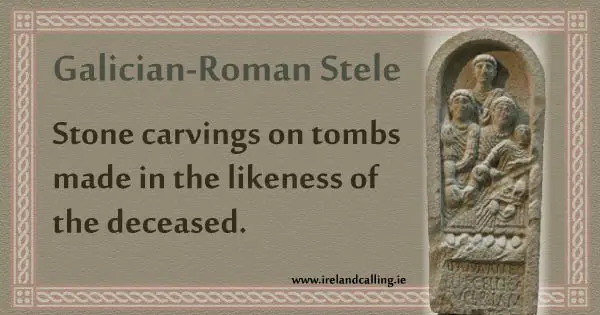
Decorative mosaics also made their way to Ireland possibly paving the way for the famous Celtic knot.
Christianity – huge impact on Celtic art
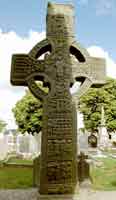
Following the Departure of the Romans from Britain around 400 AD, the introduction of Christianity to Ireland brought with it influences from the Mediterranean and Germania.
Art was used by monasteries as a tool to promote religion in beautiful manuscripts and High Cross statues around the country.
The Celtic Knot began to appear within these highly important manuscripts – known as illuminated manuscripts – intertwined with images of animals and people and often surrounded by gold leaf.
This period in Art History was known as Insular Art, alluding to the fact that Ireland and Britain were islands separated from the rest of Europe and developing their own styles.
Christianity had a massive impact on Celtic design although only a few of the early Christian illuminated manuscripts have survived through the centuries due to repeated invasion by the Vikings. These books have been well preserved and can still be viewed today.
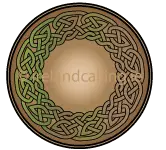 With its beautifully interwoven symmetry and its complex symbolism, the Celtic knot is what we most think of as Irish Art today. It combines the original Celtic style with the symmetry of the Roman influence and the intricacy of the Christian designs.
With its beautifully interwoven symmetry and its complex symbolism, the Celtic knot is what we most think of as Irish Art today. It combines the original Celtic style with the symmetry of the Roman influence and the intricacy of the Christian designs.
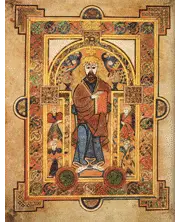 The Book of Kells is considered the most stunning of all the illuminated manuscripts. It was created around 800 AD containing the four books of the New Testament written in Latin. For many years the book was housed at The Abbey of Kells where it managed to survive numerous Viking raids. It is now on permanent display at Trinity College Library in Dublin.
The Book of Kells is considered the most stunning of all the illuminated manuscripts. It was created around 800 AD containing the four books of the New Testament written in Latin. For many years the book was housed at The Abbey of Kells where it managed to survive numerous Viking raids. It is now on permanent display at Trinity College Library in Dublin.
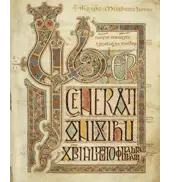 The Monastery at Lindisfarne off the north east coast of England was found by the Irish monk Saint Aidan and the illuminated manuscripts, The Lindisfarne Gospels, were created there a few decades later. These manuscripts are illustrated using a mix of Celtic, Roman and Germanic styles, a stunning example of Insular Art.
The Monastery at Lindisfarne off the north east coast of England was found by the Irish monk Saint Aidan and the illuminated manuscripts, The Lindisfarne Gospels, were created there a few decades later. These manuscripts are illustrated using a mix of Celtic, Roman and Germanic styles, a stunning example of Insular Art.
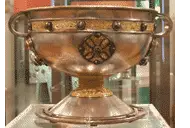 The Ardagh Chalice was created between 700 and 800 AD. It was discovered buried in a field in Co. Limerick in 1868 with more brooches that together make up the Ardagh Hoard. The Chalice is believed to have been buried during Viking occupation, perhaps to save it from being pillaged as many things were. It is another fine example of early Christian Insular Art with its intricate interlacing patterns and skilled metalwork.
The Ardagh Chalice was created between 700 and 800 AD. It was discovered buried in a field in Co. Limerick in 1868 with more brooches that together make up the Ardagh Hoard. The Chalice is believed to have been buried during Viking occupation, perhaps to save it from being pillaged as many things were. It is another fine example of early Christian Insular Art with its intricate interlacing patterns and skilled metalwork.
Read about the devastating impact of the Vikings and the Normans
Irish Art
Roman Influence on Irish art
Vikings –destroyers and creators of Irish art
Irish art revival from 19th century
art.html”]
More on Irish Art
More popular articles
https://irishhistorybitesize.com/modern/varadkar-united-ireland/
https://irishhistorybitesize.com/modern/bullying-british-demands-over-irish-border/
https://irishhistorybitesize.com/modern/british-prime-minister-theresa-may-warns-of-a-united-ireland-if-theres-a-no-deal-brexit/
https://irishhistorybitesize.com/modern/irish-taoiseach-shreds-british-prime-minister/
https://irishhistorybitesize.com/modern/100-years-ago-border-ireland-bring-down-government/
https://irishhistorybitesize.com/uncategorized/brexit-northern-ireland/
https://irishhistorybitesize.com/modern/brexit/
https://irishhistorybitesize.com/modern/british-politician-clanger/
